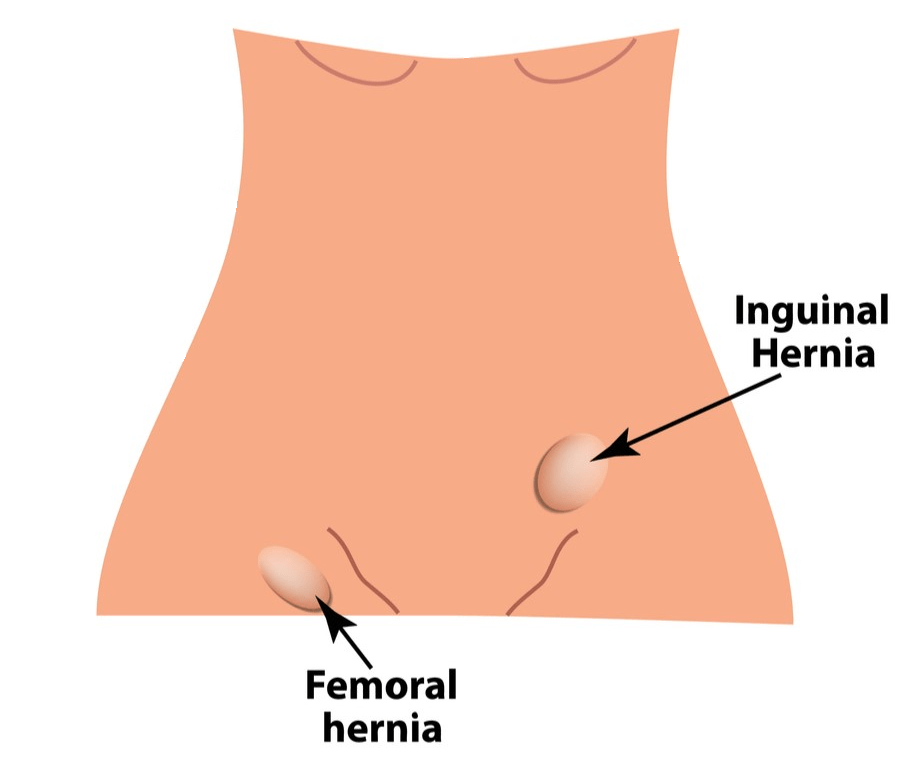Groin Hernias
If you’ve been diagnosed with a groin hernia, or think you might have one, you may be wondering what your next steps are. At Hernia Clinic Hampshire, we will put you at ease and show you that hernia treatment can be quick and straightforward.
We are experts at repairing groin hernias in a diverse range of patients, both male and female, young and old and with different health conditions and needs.

What Are Inguinal Hernias?
Inguinal hernias are the most common type of hernia . They affect more men than women by a factor of 9:1. These hernias form in a naturally weak area of the abdominal wall called the inguinal canal. This canal is a space created between the muscle layers near the groin by the tubes running to the testicle in men or round a ligament in women.
The canal extends a few centimetres running from a hole in the inner muscle layers of the groin called the deep ring and exits in the superficial layer of the abdominal wall called the superficial ring. Hernias can either work through the deep ring widening it enough to allow tissue from inside the abdomen to get into the canal, or they create a split in the posterior muscles next to the deep ring, pushing abdominal tissue into the canal.
2. What Are Femoral Hernias?
Femoral hernias are in a similar position to inguinal hernias, but the natural weakness is in the femoral canal rather than the inguinal canal. They can be hard to differentiate, particularly in women.
The femoral canal is where the femoral vein enters the pelvis from the thigh, a space exists that allows the femoral vein to expand as blood return increases with exercise, walking, changing hydration, etc. Due to gravity, femoral hernias can push through into this space.
Our Consultant Surgeon is highly experienced at repairing female groin hernias as well as femoral hernias in both men and women.
See our web page about hernias in women for more information
Our Approach to Groin Hernia Repair
For groin hernia repairs, we often recommend an open surgery using local anaesthetic and sedation. Our skilled Consultant Surgeon perfected this approach during Covid-19 as a lower-risk alternative to general anaesthetic with a simpler recovery. In fact, we are one of the only experts in the area using this approach.
We repair a lot more hernias than many other general surgeons – around 2,000 hernias so far! Our results are proven, based on patient feedback and our own Clinical Outcomes study.
Read more about the benefits of Local Anaesthesia for Hernia Surgery
Alternatively, we also offer laparoscopic (keyhole) surgery, but this approach has to be performed under general anaesthesia. We can also repair 2 inguinal hernias (bilateral inguinal hernias) or even a combination of groin and another type of hernia at the same time. Repair of 2 or more hernias at the same time is considered and managed based upon each patient’s personal situation.
Our highly experienced Consultant Surgeon will help you understand your options, and choose the best treatment for your unique situation with you.
Read more about when to use a Laparoscopic Approach for Hernia Surgery
What Previous Groin Hernia Patient Have to Say About Us:
Exemplary service. This was my first experience of surgery, and I was naturally apprehensive. From arriving at the hospital on the day of surgery I felt completely at ease. All of the staff were very considerate, and everything was carefully explained. I felt very relaxed during the surgery.
Throughout the whole process I have felt totally supported. After 8 weeks since my surgery, I am fully recovered and feel so much better. Opting for surgery was one of the best things I have ever done.
I had an inguinal hernia repair. From diagnosis to surgery was 3 weeks. I was extremely nervous on surgery day having never had an operation before, all the staff were wonderful and very professional.
When I had questions in the weeks after the surgery, I was able to call and speak to someone who helped me with my recovery.
It is now 5 weeks since my procedure and I am back in the gym (cardio only!) And back at work with no ill effects. This has all been so well managed, it has probably impacted my life less than a bad case of the flu.
How Much Does Groin Hernia Treatment Cost?
We offer competitively priced, all-inclusive groin hernia surgery packages starting from £3,600. Private financing can be arranged, and we also work with all medical insurance providers.
Choose Hernia Clinic Hampshire and invest in a straightforward, high-quality treatment and our supportive team will help you get back to the things that matter, free from discomfort.
